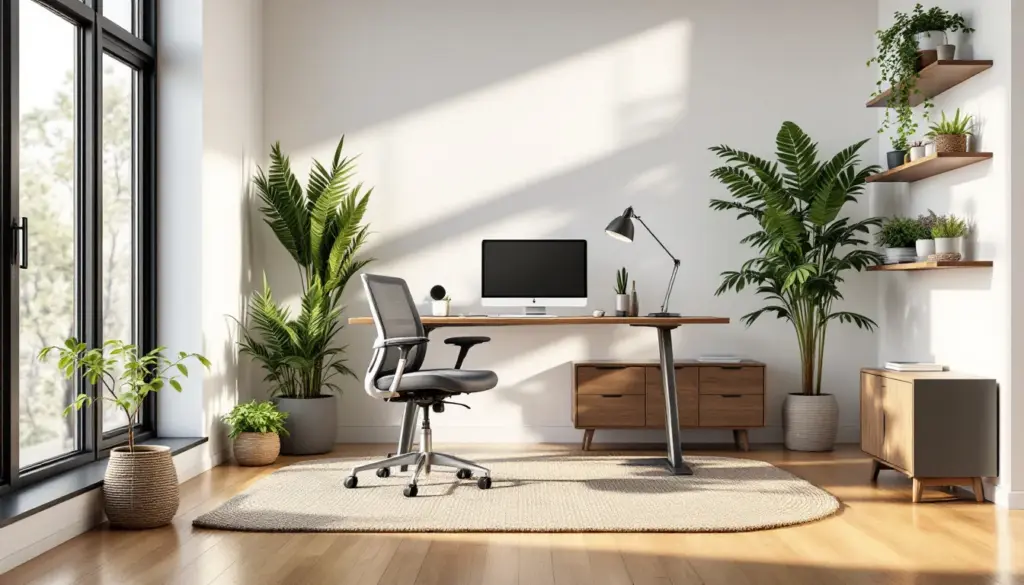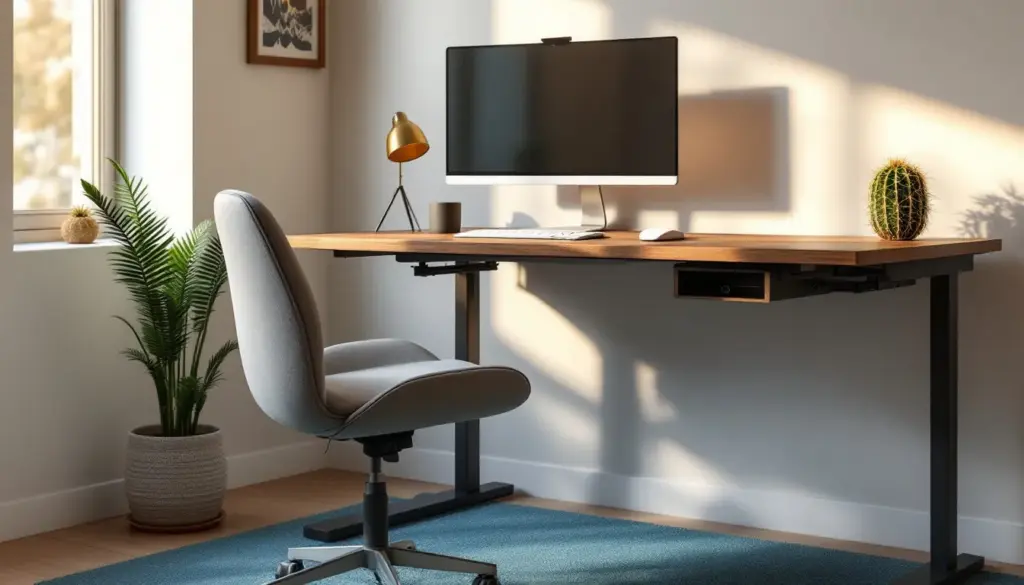Creating a home office that supports your mental health while boosting productivity doesn’t have to be complicated. With the right design choices, you can transform your workspace into a calming yet efficient environment.
Research shows that ergonomic setups can increase productivity by up to 40%, while incorporating natural elements, such as plants or natural light, can reduce stress and improve focus.
By blending ergonomic principles with biophilic design, you can craft a space that not only looks great but also helps you stay sharp and balanced throughout the day.
Whether you’re working remotely full-time or just need a dedicated spot for tasks, these strategies can make your home office a place where you thrive. Let’s explore how to design a workspace that works for you.
Home Office Designs That Boost Productivity And Mental Health
Creating a home office that supports both productivity and mental health involves thoughtful design choices. By combining ergonomic principles with biophilic elements, you can craft a workspace that enhances focus and reduces stress.
The Evolution of Home Offices
The shift to remote work has transformed home offices from temporary setups to permanent fixtures.
Meanwhile, biophilic elements, such as natural light and indoor plants, reduce stress and improve cognitive function. These strategies ensure your workspace supports long-term health and focus.
This change demands designs that balance efficiency with mental well-being. Ergonomic interventions, like adjustable desks and chairs, can boost productivity by up to 40%.
Ergonomics: The Foundation of Productive Workspaces
Creating a home office that supports your mental health starts with ergonomics. By designing a workspace that minimizes physical strain, you can boost productivity and reduce the risk of injuries.
The Science of Ergonomic Design
Ergonomic setups improve productivity by 40% and reduce musculoskeletal disorders, which account for 41% of workplace injuries. These principles focus on aligning your workspace with your body’s natural movements, ensuring comfort and efficiency.
Adjustable Furniture
Chairs with lumbar support and desks that allow your elbows to rest at 90-degree angles prevent spinal compression and shoulder fatigue. Adjustable furniture adapts to your body, reducing the risk of long-term discomfort.
Monitor Placement
Position your screen at eye level and an arm’s length away to avoid neck strain and eye fatigue. Pair this with natural lighting to minimize glare and create a more comfortable viewing experience.
Active Workstations
Standing desks or treadmill desks counteract the negative effects of sitting for long periods. These options improve circulation, reduce cardiovascular risks, and keep your mind sharp throughout the day.
By incorporating these ergonomic strategies, you’ll not only work more efficiently but also protect your long-term health.

Biophilic Design: Bridging Nature and Productivity
Biophilic design connects your workspace to nature, creating an environment that reduces stress and boosts productivity. By integrating natural elements, you can enhance mental clarity and physical well-being, making your home office a sanctuary for focus and creativity.
Integrating Natural Elements
Biophilic design taps into your natural affinity for nature, creating spaces that feel calming and stimulating. Exposure to natural light increases vitamin D levels, regulates your sleep cycle, and reduces feelings of depression.
Incorporating plants, natural materials, and visual connections to nature can transform your home office into a healthier, more inspiring space.
Plant Integration
Plants do more than beautify your workspace; they improve air quality and reduce stress. Dark green plants, such as ferns or snake plants, promote relaxation, while red varieties like crotons can sharpen focus.
Living walls or potted succulents filter out harmful VOCs, aligning with air quality standards and enhancing your mental clarity.
Natural Materials
Using materials like wood, stone, and natural fibers brings the outdoors inside, creating a serene and welcoming environment. These textures evoke a connection to nature, making your workspace feel grounded and balanced.
For example, a wooden desk or stone accents can add warmth and sophistication to your home office.
Visual Connections to Nature
Incorporate elements that mimic natural patterns, such as artwork featuring landscapes or windows that frame outdoor views. These visual connections to nature reduce mental fatigue and create a sense of openness, even in smaller spaces.
Minimalist decor with neutral tones and natural textures can further enhance this effect, keeping your workspace clutter-free and visually calming.
The WELL Building Standard: A Blueprint for Holistic Health
The WELL Building Standard offers a science-backed framework to create home offices that support both productivity and mental well-being. Its 10 core concepts, including Air, Water, Nourishment, Light, Movement, Thermal Comfort, Sound, Materials, Mind, and Community, provide actionable strategies for designing healthier workspaces.
Core Principles for Home Offices
The WELL Standard’s principles transform home offices into spaces that combat mental fatigue and sustain focus. By addressing air quality, lighting, and acoustics, you can create an environment that enhances both physical and mental health.
Air Quality
High-efficiency particulate air (HEPA) filters and VOC-free materials improve indoor air quality, reducing respiratory issues and cognitive decline. Clean air keeps you alert and focused throughout the day.
Circadian Lighting
Tunable LED systems mimic natural daylight patterns, boosting alertness during work hours and improving sleep quality afterward. Proper lighting reduces eye strain and supports your body’s natural rhythms.
Acoustic Control
Soundproofing materials and strategic layouts minimize noise distractions, creating a quieter, more focused workspace. Effective acoustic control helps maintain concentration and reduces stress.
Mental Health Strategies: Designing for Psychological Resilience
Creating a home office that supports mental health involves thoughtful design choices. By reducing cognitive load and fostering calm, you can enhance focus and resilience in your workspace.
Reducing Cognitive Load Through Design
Clutter increases cortisol levels, making it harder to focus and solve problems. A well-organized space helps you think clearly and stay productive.
Minimalist Layouts
Floating shelves and concealed storage systems keep your workspace tidy. These solutions minimize visual chaos, helping you maintain mental clarity throughout the day.
Color Psychology
Muted blues and greens create a calming atmosphere, while warm neutrals add comfort without overstimulation. Avoid stark whites, as they can increase anxiety and disrupt focus.
Dedicated Zones
Separate your workspace from living areas using room dividers or strategic furniture placement. This reinforces work-life boundaries, helping you mentally switch between tasks and relaxation.

Promoting Emotional Well-being
Creating a home office that supports emotional well-being involves thoughtful design choices that reduce stress and foster mental resilience. By incorporating mindfulness corners and community integration, you can create a space that nurtures both focus and connection.
Mindfulness Corners
Designated spaces for meditation or yoga, such as small nooks with cushions or mats, encourage mental breaks and reduce burnout.
By carving out a dedicated spot for relaxation, you create a physical reminder to pause and reset, which enhances emotional balance and productivity.
These areas provide a quiet retreat for mindfulness practices, helping you recharge during the workday.
Community Integration
Virtual coworking platforms or local meetups replicate office camaraderie, combating the loneliness often linked to remote work. These connections foster a sense of belonging and reduce feelings of isolation.
Whether you join an online coworking session or attend a local networking event, integrating community into your routine helps maintain social bonds and emotional well-being.
Future-Proofing Home Offices: Trends and Innovations
As remote work becomes a permanent fixture, designing a home office that adapts to your needs is essential. Emerging trends focus on integrating technology and flexibility to create spaces that support both productivity and mental well-being.
Adaptive Technologies
AI-driven climate control systems adjust your workspace temperature for optimal comfort, while smart desks with posture alerts help you maintain proper alignment. EMF-blocking materials reduce exposure to electromagnetic fields, addressing growing health concerns.
UV-C sanitizers, aligned with the WELL Building Standard, ensure a cleaner environment, promoting both physical and mental health.
Hybrid Work Models
With 72% of employees favoring hybrid work, your home office must adapt to changing demands.
Modular furniture, like adjustable desks and stackable chairs, allows you to reconfigure your space effortlessly. Multipurpose rooms with foldable workstations make it easy to switch between focused tasks and collaborative videoconferencing, ensuring your workspace remains versatile and functional.
Synthesizing Productivity and Well-being
Your home office isn’t just a workspace; it’s a reflection of your well-being. By blending ergonomic principles with biophilic design and mindful organization, you can create an environment that supports both your mental health and productivity.
From adjustable furniture to natural light and calming colors every choice you make contributes to a space that helps you thrive. Don’t forget to carve out moments for mindfulness and connection whether through a cozy meditation corner or virtual coworking.
As remote work continues to evolve your home office can adapt too. With thoughtful design it’ll remain a sanctuary where you can focus recharge and feel your best.
Here’s to building a workspace that works for you!

